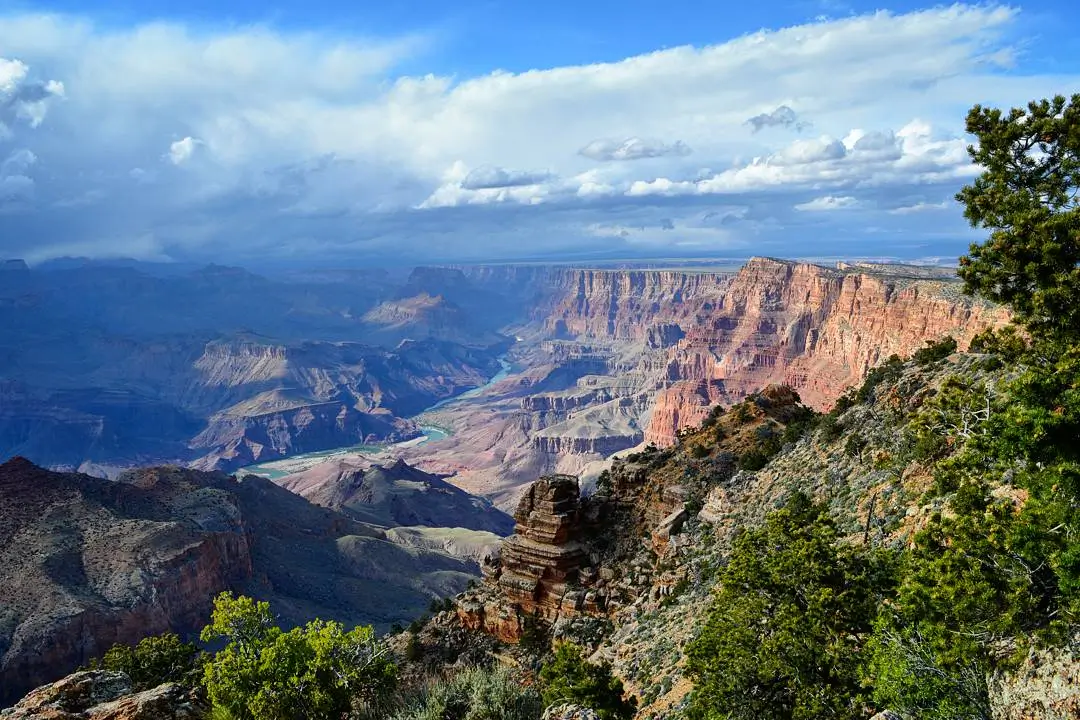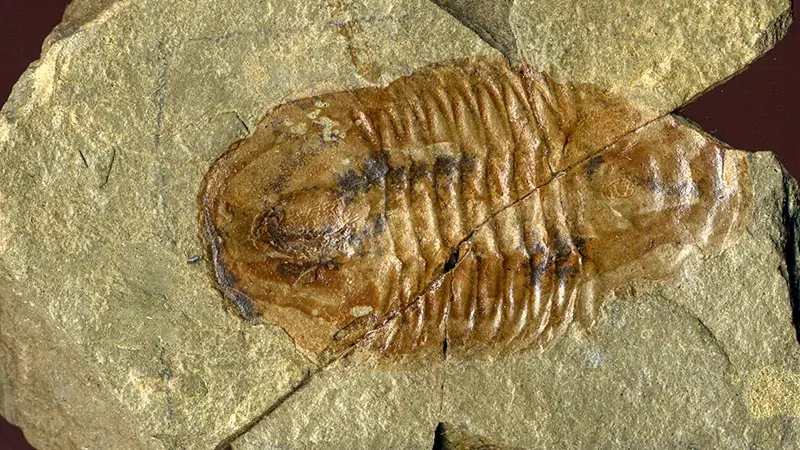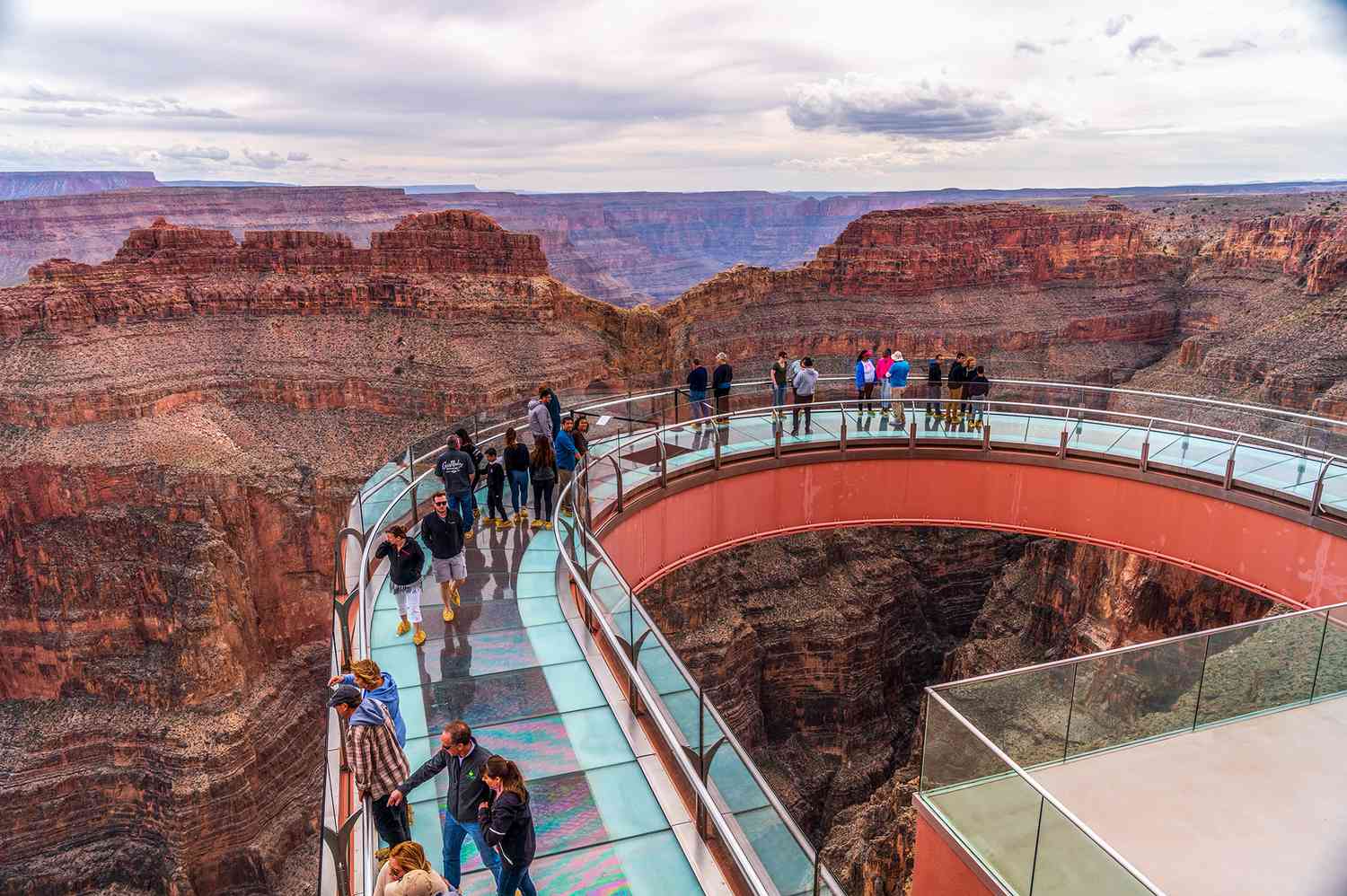The Grand Canyon is a world-renowned geologic showcase, exposing one of the most complete and awe-inspiring slices of Earth’s crust. Scientists have been studying its rocks and formations since the 19th century, drawn by the canyon’s unparalleled record of geologic time.
What makes this natural wonder truly unique is not just its enormous size, but the story it tells: how it formed, the many rock layers and their ages, the mighty Colorado River’s role in carving it, the fossils of ancient life entombed in its walls, and the ongoing scientific discoveries that continue to refine our understanding.
In a sense, the Grand Canyon is like a window into deep time, a place where anyone can see the strata (layers of rock) and learn how our planet’s surface has changed over unfathomable ages.
Learn more about the Grand Canyon
Formation of the Grand Canyon
The Grand Canyon’s geologic story begins long before the chasm existed. Nearly two billion years ago, the foundation was laid with the formation of ancient igneous and metamorphic rocks at the canyon’s bottom (the “basement” rocks visible in the inner gorge).
Over immense spans of time, layer upon layer of sedimentary rock accumulated on top of this basement. These layers were deposited as environments changed – oceans advanced and retreated, coastlines migrated, deserts and swamps came and went – each leaving behind new sediments that eventually hardened into rock.
Geologists summarize this long pre-canyon phase with a simple acronym: D.U.D.E., which stands for Deposition, Uplift, Downcutting, and Erosion. In the deposition stage, countless strata were laid down flat, one atop another, recording roughly 1.8 billion to 270 million years ago of Earth’s history in the canyon’s walls.
Next came the Uplift. Between about 70 and 30 million years ago, tectonic forces (the same kind that build mountains) uplifted the Colorado Plateau, raising the whole region by thousands of feet. Remarkably, this uplift happened without severely crumpling or tilting the rock layers. Instead of forming a jagged mountain range, the plateau rose flat and high.
In contrast, when the Rocky Mountains rose, their rocks were intensely bent and broken. The Grand Canyon’s rocks remained mostly horizontal, just elevated to heights of up to 7,000–8,000 feet above sea level.
This raised plateau set the stage for the canyon to form: it positioned the hard layers high enough for a river to later cut down through them. Geologists are still investigating how such broad uplift occurred with so little deformation; hypotheses involve unusual plate tectonics, such as a shallow-angle subduction of an ancient ocean plate, and gradual rising of the crust due to isostatic rebound (the crust lifting as heavy overlying rocks erode away).
Rock Layers
Stepping back and gazing at the Grand Canyon’s walls is like looking at a giant layer cake of Earth’s history. Nearly 40 identified rock layers stack upon one another in the canyon, recording a vast span of geological time. The oldest layers lie at the bottom and the youngest at the top, following the geologic principle of superposition.
At the very base, in the inner gorge, dark Vishnu Schist and related rocks date back about 1.7–1.8 billion years – part of the ancient Precambrian basement. Above them, in certain areas, are tilted remnants of the Grand Canyon Supergroup (about 1.2 billion to 800 million years old), which hint at long-vanished mountains and basins. Most prominent, however, are the overlying Paleozoic Era layers, which form the bright bands of cliffs and slopes visible throughout the canyon.
Between roughly 540 and 270 million years ago, during the Paleozoic, this region experienced dramatic environmental shifts that produced the sedimentary rocks we see today. For example, the Tapeats Sandstone at the base of the canyon’s broad slope (the Tonto Platform) represents ancient beach sands from the Cambrian Period, when a shallow sea flooded the land.
Above it, the Bright Angel Shale and Muav Limestone were deposited slightly later as that sea deepened – these greenish and gray layers are rich in marine fossils from the Cambrian explosion, when early animals with shells proliferated. Jumping upward in time (and higher in the wall), the massive Redwall Limestone (Mississippian Period, 340 million years old) forms sheer cliffs and was laid down in a warm tropical sea teeming with marine life.
In contrast, the Hermit Shale (Permian Period) above the Redwall forms gentler slopes and preserves signs of coastal plains or swampy environments, including fossil plants. Capping the sequence is the Kaibab Limestone (Permian, 270 million years old), which makes up the canyon’s rimrock.
Interestingly, the Kaibab Limestone was formed on an ancient seafloor – yet today it sits about 7,000–8,000 feet above sea level atop the plateau , clear evidence of the uplift that affected this whole region.
Notably, the Grand Canyon’s rock record has some missing chapters. Above the Kaibab (the youngest exposed layer at 270 million years), there were once additional layers from the Mesozoic Era (“Age of Dinosaurs”) that have since been almost completely eroded away. Geologists infer that after 250 million years ago, seas and deserts continued to leave sediments (including dinosaur-age rocks) in what is now the canyon area.
However, those layers were later stripped off, long before the canyon itself formed. This is why you won’t find dinosaur bones inside the main Grand Canyon – the rocks exposed in the cliffs are far older than the dinosaurs. What remains is a phenomenal cross-section from the early Precambrian to the late Paleozoic, with only small scraps of younger rocks preserved here and there beyond the canyon’s rim.
This extensive, relatively undisturbed sequence makes the Grand Canyon invaluable for geologists: by studying differences between each layer – sandstone to shale to limestone and so on – scientists can read the shifting environments and events that unfolded in this region over hundreds of millions of years.
The Colorado River’s Role in Carving the Canyon

After the rocks were in place and the plateau uplifted, the stage was set for the Grand Canyon’s most dramatic sculptor: the Colorado River. The canyon itself is geologically young compared to the ancient rocks it slices through.
Current evidence suggests that the Colorado River began carving downward into the plateau around 5 to 6 million years ago, creating the Grand Canyon we know today. This process – the downcutting of a river into land – was immensely accelerated by certain conditions present here.
First, the Colorado River had a steep gradient through the rising plateau, dropping roughly 2,000 feet in elevation over the 277 miles of the canyon. A steep slope means fast-flowing water, and faster currents have more power to grind away rock. Second, the river carried a relatively large volume of water (especially during ice age meltwater floods) loaded with sand and gravel, turning the river into a natural sandblasting tool.
Third, the Colorado Plateau’s arid climate worked in the river’s favor: sparse vegetation and little soil meant the rock was bare and exposed to weathering, so it was easier for the river to cut through the weakened, cracked rock layers.
During periodic floods, the Colorado River could carry boulders and debris that crash and collide along the riverbed, chipping away pieces of rock like chisels. Over millions of years, this relentless erosion excavated a chasm over a mile deep in places. The canyon’s depth far exceeds its width in many sections, resulting in those vertical cliffs and steep slopes that leave visitors staring agape over the edge.
That shape is also a product of climate: in a wetter region, side valleys and vegetation might soften the landscape into rolling hills. But in the dry Southwest, canyon widening is slow – rain is infrequent and plant cover sparse, so most erosion comes from infrequent but intense storms cutting narrow side gullies.
The harder rock layers (like the Redwall Limestone and Coconino Sandstone) resist erosion and form sheer cliffs, whereas softer layers (like the Bright Angel Shale or Hermit Shale) wear away more easily, forming gentler terraces or slopes in the canyon wall. This interplay of rock hardness and erosion gives the canyon its stair-stepped profile.
It’s important to realize that the Grand Canyon continues to evolve today. The Colorado River is still flowing, though now regulated by upstream dams that have reduced its natural flood extremes. Given enough time, the canyon will keep widening (even if more slowly than before) as tributary streams and weather chip away at its sides.
The downcutting of the river has slowed, however, because it has already reached some of the hardest ancient rocks at the canyon’s depths, and its gradient has lessened as it approaches sea level. Eventually, perhaps millions of years in the future, the canyon might become even broader and more majestic – a testament to the never-ending processes of erosion and change.
Evidence of Prehistoric Life in the Canyon

The Grand Canyon’s rocks not only reveal geologic processes, but also preserve fossils that illuminate chapters of life’s history. Most of the sedimentary layers in the canyon contain fossils of some kind, especially the Paleozoic Era rocks.
In the lowermost sedimentary layers (around Cambrian Period, 500 million years old), we find marine fossils from a time when life on Earth was exploding in diversity. For instance, the Bright Angel Shale and Muav Limestone contain abundant remains of trilobites – extinct marine arthropods somewhat akin to horseshoe crabs – along with brachiopods (ancient shellfish) and even primitive algae and sponges.
These creatures lived in a shallow sea that once covered this area, and their shells and traces became entombed in the mud and lime that turned to rock. In fact, fossil trilobite trails and burrows have been found, recording the movements of these long-vanished animals on the sea floor.
Climbing higher in the canyon (and forward in time), the fossils change, reflecting evolutionary progress and new environments. The Devonian-aged Temple Butte Formation (385 million years old) has yielded remains of early fish – armored jawed fish known as placoderms. In some of the Carboniferous and Permian strata (340–270 million years old), we see evidence of life venturing onto land.
Fossilized plant remains (ferns and other primitive plants) appear in layers like the Hermit Shale, indicating swampy coastal plains that existed here before the age of dinosaurs. Perhaps most exciting are the trackways – preserved footprints – of early four-legged animals.
In 2019, paleontologists announced the discovery of several fossil trackways in the Coconino Sandstone (a Permian desert sandstone near the top of the canyon) that forced scientists to rethink the timeline of vertebrates on land. The tracks, about 280 million years old, were left by a primitive tetrapod (four-legged animal) in what was then a vast sand dune desert.
The footprints – identified as the ichnogenus Ichniotherium – likely belong to a diadectomorph, an early reptile-like creature, making it the earliest evidence of such an animal living in a true desert environment. This was a surprise because these creatures were not thought to be well adapted to arid conditions, yet here we have literal steps of one walking across dry dunes.
From algae and trilobites to ancient amphibians and reptile relatives, the Grand Canyon’s fossils offer a remarkable record of prehistoric life. Each layer’s fossil assemblage is distinct – a principle geologists call faunal succession, meaning different time periods have their own unique life forms in the rock record.
By studying these fossils in order from bottom to top, we essentially travel through time, witnessing life’s evolution from simple sea creatures in the Precambrian and Cambrian, to fishes, to the first land plants and animals, all recorded in stone. It’s important to note that later eras (like the Mesozoic with dinosaurs, or the Cenozoic with mammals) are mostly absent from the canyon’s walls due to the aforementioned gaps in the rock record.
However, on the plateaus above or in nearby regions, geologists have found dinosaur footprints and bones in younger rocks, showing that even though the canyon’s story “skips” those chapters, the broader region does contain evidence of those ages.
Overall, the canyon’s fossil record is a treasure trove for paleontologists, offering insights into ancient environments ranging from Cambrian seas to Permian deserts.
Ongoing Scientific Research and Discoveries
One might think that such a famous geologic feature would have given up all its secrets by now, but the Grand Canyon remains an active area of research, and new discoveries are still being made.
Geologists and paleontologists continue to refine the timeline of events and uncover details that add to the canyon’s story. In fact, as recently as 2024, a team of scientists published new findings on the Grand Canyon’s Cambrian rock layers, the Tonto Group, which includes formations like the Tapeats Sandstone and Bright Angel Shale.
By applying modern techniques and models, they updated a classic stratigraphic framework and revealed fresh insights about that period – such as evidence of ancient global sea-level rise and even the impact of powerful storms during Cambrian time.
Studies like these show how the canyon’s rocks serve as a “Rosetta Stone” for geology, helping scientists decode broader patterns of Earth’s history, from climate shifts to tectonic movements.
Another area of ongoing research is the origin of the Colorado River and the canyon itself. While we know the canyon was carved in the last 5-6 million years, scientists are still debating the precise sequence of events that led the river to take its present course.
Was the river once two separate rivers that eventually linked up? Did it spill over from a basin to carve the canyon in a geologic instant, or did it slowly gnaw through plateau barriers? Various hypotheses – from ancient lakes that overflowed catastrophically, to underground water systems collapsing and routing the river – have been proposed to explain how the river managed to cut across high terrain like the Kaibab Plateau.
Recent ideas even suggest that collapse of cave systems (karst) might have helped the river punch through obstacles. Researchers are actively gathering evidence to test these ideas, such as dating mineral deposits and analyzing gravel remnants, to piece together the canyon’s early carving history. It’s a vivid reminder that geology is very much a living science – even at the Grand Canyon, new chapters are being added to the geologic textbook.
Moreover, the Grand Canyon’s extreme depth and exposed layers offer a perfect outdoor laboratory for many disciplines. Volcanologists study remnants of ancient lava flows that once dammed the canyon (there are hardened lava cascades and ash layers indicating volcanoes were active near the canyon as recently as 500,000 years ago).
Seismologists and structural geologists examine faults that cut across the canyon, which reveal uplift and earthquake activity in the past and help gauge how fast the river has been cutting down.
And as we saw, paleontologists are continually on the lookout for new fossils – such as the groundbreaking footprint find – that can rewrite what we know about ancient life and environments. Each discovery, whether it’s a tiny fossil or a new analysis of rock chemistry, adds a piece to the puzzle of the Grand Canyon’s history.
In summary, the Grand Canyon stands not only as a breathtaking landscape but as a rich archive of geological and paleontological information. It uniquely combines spectacle with science: layer by layer, it tells the tale of oceans invading and retreating, of landscapes rising and rivers cutting down, of life’s march from simple sea creatures to the verge of the Age of Dinosaurs – and it tells this story on a scale that anyone can see with their own eyes from the rim or the river.
Geologists often say there’s no other place on Earth quite like it, where such a grand assembly of rock layers is so exquisitely exposed. As research continues, our understanding of the Grand Canyon’s formation and its role in Earth’s history only deepens.
For the curious traveler, this means that visiting the canyon is not just a visual feast, but an educational journey through time. Standing on the rim, you are looking at the result of two billion years of Earth’s processes – truly a unique window into the science of our planet’s past, carved by nature’s patient hand.


